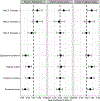Individual and joint effects of prenatal PM2.5 and maternal stress on child temperament
- PMID: 38354885
- PMCID: PMC11065570
- DOI: 10.1016/j.envres.2024.118432
Individual and joint effects of prenatal PM2.5 and maternal stress on child temperament
Abstract
Prenatal fine particulate matter (PM2.5) and maternal psychological functioning have been associated with child cognitive outcomes, though their independent and joint impacts on earlier behavioral outcomes remains less studied. We used data from 382 mother-child pairs from a prospective birth cohort in Mexico City. Temperament was measured at 24 months using the Carey Toddler Temperament Scale (TTS). Exploratory factor analysis (EFA) was used to update the factor structure of the TTS. During pregnancy, mothers completed the Crisis in Family Systems-Revised, Edinburgh Depression Scale, pregnancy-specific anxiety scale, and the Perceived Stress Scale. Pregnancy PM2.5 was assessed using estimates from a satellite-based exposure model. We assessed the association between prenatal maternal stress and PM2.5 on temperament, in both independent and joint models. Quantile g-computation was used to estimate the joint associations. Models were adjusted for maternal age, SES, education, child sex, and child age. In EFA, we identified three temperament factors related to effortful control, extraversion, and negative affect. Our main results showed that higher levels of PM2.5 and several of the maternal psychological functioning measures were related to both effortful control and negative affect in the child, both individually and as a mixture. For instance, a one quartile increase in the prenatal mixture was associated with higher negative affect scores in the child (0.34, 95% CI: 0.16, 0.53). We observed modification of these associations by maternal SES, with associations seen only among lower SES participants for both effortful control (-0.45, 95% CI: -0.70, -0.20) and negative affect outcomes (0.60, 95% CI: 0.35, 0.85). Prenatal PM2.5 and maternal psychological functioning measures were associated with toddler temperament outcomes, providing evidence for impacts of chemical and non-chemical stressors on early child health.
Keywords: Child temperament; Mixtures; Particulate matter; Physiological stress; Pregnancy.
Copyright © 2024 Elsevier Inc. All rights reserved.
Conflict of interest statement
Declaration of competing interest The authors declare that they have no known competing financial interests or personal relationships that could have appeared to influence the work reported in this paper.
Figures


Similar articles
-
Toddler temperament and prenatal exposure to lead and maternal depression.Environ Health. 2016 Jun 16;15(1):71. doi: 10.1186/s12940-016-0147-7. Environ Health. 2016. PMID: 27312840 Free PMC article.
-
Prenatal PM2.5 exposure and infant temperament at age 6 months: Sensitive windows and sex-specific associations.Environ Res. 2022 Apr 15;206:112583. doi: 10.1016/j.envres.2021.112583. Epub 2021 Dec 17. Environ Res. 2022. PMID: 34922978 Free PMC article.
-
Prenatal PM2.5 exposure and behavioral development in children from Mexico City.Neurotoxicology. 2020 Dec;81:109-115. doi: 10.1016/j.neuro.2020.09.036. Epub 2020 Sep 17. Neurotoxicology. 2020. PMID: 32950567 Free PMC article.
-
Maternal fine particulate matter (PM2.5) exposure and adverse birth outcomes: an updated systematic review based on cohort studies.Environ Sci Pollut Res Int. 2019 May;26(14):13963-13983. doi: 10.1007/s11356-019-04644-x. Epub 2019 Mar 20. Environ Sci Pollut Res Int. 2019. PMID: 30891704
-
Air pollution and children's health-a review of adverse effects associated with prenatal exposure from fine to ultrafine particulate matter.Environ Health Prev Med. 2021 Jul 12;26(1):72. doi: 10.1186/s12199-021-00995-5. Environ Health Prev Med. 2021. PMID: 34253165 Free PMC article. Review.
References
-
- Thomas A, Chess S. Temperament and development. Brunner/Mazel; 1977.
-
- Bould H, Araya R, Pearson RM, et al. Association between early temperament and depression at 18 years. Depress Anxiety. 2014;31(9):729–736. - PubMed
-
- De Pauw SSW, Mervielde I. Temperament, personality and developmental psychopathology: a review based on the conceptual dimensions underlying childhood traits. Child Psychiatry Hum Dev. 2010;41(3):313–329. - PubMed
-
- Nigg JT. Temperament and developmental psychopathology. J Child Psychol Psychiatry. 2006;47(3–4):395–422. - PubMed
Publication types
MeSH terms
Substances
Grants and funding
LinkOut - more resources
Full Text Sources
Medical

